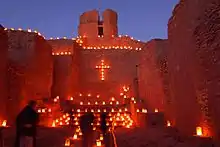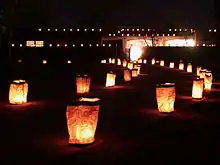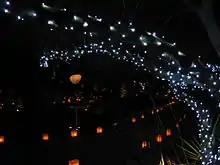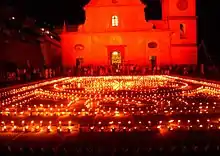Luminaria
A luminaria or farolito[nb 1] (see naming disagreement section below) is a small paper lantern (commonly a candle set in some sand inside a paper bag) which is of significance in the U.S. state of New Mexico in southwest United States at Christmas time, especially on Christmas Eve. They are also used in Hispanic culture. These paper lanterns have to some extent replaced the older tradition of the vigil fire luminaria with which they became confused.


Yet another form of luminaria, a small torch or large candle, is carried by the leader of the procession of Las Posadas,[2] a nine-day holiday running December 16–24.
Electrically-lit luminarias are also used, consisting of a string of standard incandescent "Christmas lights" with the bulbs covered with a tan plastic sleeve, made to about the size and shape of a small paper bag.
Origin
The use of paper lanterns during the Christmas Novena procession originates from the similar parol (Spanish farol) tradition of the Philippines which use lanterns made with bamboo and Japanese paper. These were introduced to New Spain via the Manila galleons.[3][4][5][6][7]
Christmas tradition


The early versions were actually small bonfires of crisscrossed piñon branches which were built in three-foot high squares. Today, luminarias are made from brown paper bags weighted down with sand and illuminated from within by a lit candle. These are typically arranged in rows to create large and elaborate displays. The hope among Roman Catholics is that the lights will guide the spirit of the Christ child to one's home.
Strings of artificial luminarias, with plastic bags illuminated by small light bulbs and connected by an electrical cord, are also available, and are common in the American Southwest, where they are typically displayed throughout the year-end holiday season. These are beginning to gain popularity in other parts of the United States.[8]
Santa Fe and Old Town Albuquerque, New Mexico, are well known for their impressive Christmas Eve farolito displays.[9] Farolito displays are common throughout New Mexico, and most communities in New Mexico have farolitos in prominent areas such as major streets or parks. Residents often line their yards, fences, sidewalks, and roofs with farolitos. Similar traditions can now also be found in many other parts of the nation.
The University of New Mexico in Albuquerque, New Mexico hosts the annual Hanging of the Greens tradition with over 14,000 luminarias, hot posole, and Christmas carols. [10]
New Mexico State University in Las Cruces, New Mexico holds an annual event called Noche de Luminarias in early December, which features over 10,000 luminarias across campus. [11]
San Juan College in Farmington, New Mexico, organizes a large annual farolito display, most recently consisting of around 30,000 farolitos displayed on campus.[12]
At historic Temple Square in Salt Lake City, Utah, metal luminarias decorate the grounds near the Church Office Building of The Church of Jesus Christ of Latter-day Saints.Tiny holes have been punched in the metal to create designs featuring scenes from the life of Jesus Christ and Christmas messages in a variety of languages.[13] Some of the luminaries are the traditional bag shape, while others are large cans.[14] They have been on display since before 2002, when even more were added.[15]
In West Valley City, Utah, luminarias are used to light the path during the Walk with Santa held the first Monday of December every year. The display features over 300 luminarias.
The American Cancer Society's Relay For Life fundraising events which are held all over the U.S. feature luminaria ceremonies.[16] Luminarias are placed around the track and some relay events spell out "HOPE" in stadium stands with luminarias.
The American Foundation for Suicide Prevention's[17] Out of the Darkness Overnight[18] uses luminarias at the end of the overnight walk to memorialize those lost to suicide for survivors.
Luminarias have also become popular in California in some cities. The Boy Scout Troops and Albuquerque Youth Symphony sell them around Christmas time as another form of fundraising.
On Evensham Street in the Glenshire Devonshire area of Truckee, California, local residents line the streets with luminaries. See Glenshire Devonshire's web page for aerial photos.
The Mantey Heights neighborhood of Grand Junction, Colorado has celebrated the luminaria tradition for several decades. Over 3,500 luminaries are placed along the roads and walkways every Christmas Eve. Many are positioned atop the parapets of the old adobe homes.
In Champaign, Illinois, luminarias line South Willis Ave. between Springfield Ave. and John St. for one night each holiday season.
In Galena, Illinois, luminarias line the streets of the town one night in December for their annual "Night of Luminaria."[19]
In Midlothian, Illinois, luminaria sets are sold to raise money for the local food pantries. About 75% of the food pantries annual budget comes from these luminaria sales and donations.
After the 2008 city hall shooting in Kirkwood, Missouri, residents lined the streets with luminarias to honor the victims of the shooting.
Each year for the past 22 years community members have placed luminarias along the path beside Lake Washington north of Seward Park. They place as many as 1800 along a three-mile stretch of the path. The placement of the luminaria are timed to coincide with the annual Christmas Ships festival organized by Argosy Cruises.
Other holidays
In some Southwestern states, such as Arizona and Texas as well as New Mexico, luminarias are also occasionally used as Halloween decorations, sometimes featuring jack o' lantern faces drawn on the paper bags.[20] Artificial luminarias are increasingly available with holiday themed decorative patterns and in colors other than brown.
Naming disagreement
The name of the decoration is the subject of a long-running item of contention among some New Mexicans.[21] In general, farolito is the preferred term in northern New Mexico, while the decorations are often referred to as luminarias in the southern part of the state; The central part around Albuquerque is mixed, leaning toward "luminaria". In Spanish, the word farolito translates as "little lantern", while luminaria means "festival light".[1] Historically luminaria referred not to a paper lantern but to a small festival or vigil bonfire;[7] however, this distinction is not commonly made outside of northern New Mexico.[22] New Mexico traditionalists insist that the use of luminaria to mean a paper lantern is not proper.[21] Farolitos may be referred to as "luminarias" by some, but on Christmas Eve, when the farolitos are lit in Santa Fe, luminarias (Posada vigil fires) are burning in the small mountain villages of Northern New Mexico. Luminaria bonfires made of square, stacked piñon and juniper wood can often can be seen in towns and pueblos across northern New Mexico. In the mountain villages and by the roadways they are built by local residents to welcome visitors and to commemorate holiday activities.
See also
- Festival of Lights
- Kobe Luminarie, a December electric-light festival in Japan
- Christmas lights
- Luminarias festival observed annually in San Bartolomé de Pinares
Notes
- "But farolitos and luminarias have come to mean the same thing in late 20th-century New Mexico parlance..."[1]
References
- Steinberg, David (December 19, 1997). "You say luminaria, I say farolito". Albuquerque Journal. NM. p. E16.
- "Katrina Wright: Luminarias symbolize lighting way for Christ child » Abilene Reporter-News". Reporternews.com. Retrieved 2012-04-27.
- Castro, Rafaela (2001). Chicano Folklore: A Guide to the Folktales, Traditions, Rituals and Religious Practices of Mexican Americans. OUP USA. p. 94. ISBN 9780195146394.
- Tan, Nigel (17 December 2016). "PH X'mas symbols, practices trace roots to Spanish era". Rappler. Retrieved 1 December 2020.
- Greene, Bizia (27 December 2017). "Holiday charm of farolitos started in the Philippines". Santa Fe New Mexican. Retrieved 1 December 2020.
- "Our View: Why luminarias should be your new (old) Christmas tradition". 21 December 2017. Retrieved 1 December 2020.
- Ribera Ortega, Pedro (1973). Christmas in old Santa Fe (2 ed.). Sunstone Press. pp. 14–23. ISBN 0-913270-25-3.
- "Make Lumanaries that will light the way". Futurebound.com. Archived from the original on 2012-03-01. Retrieved 2012-04-27.
- "History of Luminarias". Novato-troop42.org. Archived from the original on 2012-03-01. Retrieved 2012-04-27.
- https://timeline.unm.edu/item/hanging-of-the-greens.html
- https://campusactivities.nmsu.edu/noche-de-luminarias/
- Archived December 30, 2010, at the Wayback Machine
- "Mormon Temple Square Visitors Help 'Light the World' during the Christmas Season". newsroom.churchofjesuschrist.org. 2016-11-29. Retrieved 2019-12-05.
- "Luminarias at Christmas". www.churchofjesuschrist.org. Retrieved 2019-12-05.
- "Unique Displays Shine at Salt Lake, Washington D.C. Temples". www.churchofjesuschrist.org. Retrieved 2019-12-05.
- "Luminaria Bags, Candles & Ceremony". Relay For Life. Retrieved 2013-10-25.
- "American Foundation for Suicide Prevention". Afsp.org. 2013-09-25. Retrieved 2013-10-25.
- "AFSP : Out of the Darkness Walks". Theovernight.org. Retrieved 2013-10-25.
- "Old Fashioned Christmas in Galena - Night of the Luminaria". Visitgalena.org. Retrieved 31 July 2012.
- http://sumonova.com/luminarias-a-southwest-tradition-expanded/
- "Candles glow, dispute flares". The Milwaukee Journal. Associated Press. December 17, 1965. Retrieved 20 February 2012.
- Nylander Ebinger, Virginia (2008). Aguinaldos. Sunstone Press. p. 110. ISBN 978-0-86534-689-5.
External links
| Wikimedia Commons has media related to Luminaries. |
- Fredericksburg & Spotsylvania National Military Park. "Annual Luminaria". National Park Service. Retrieved 26 August 2010.